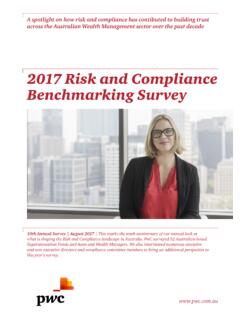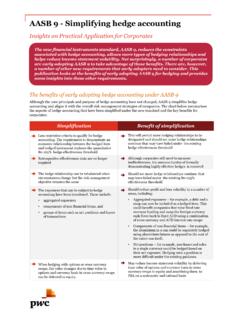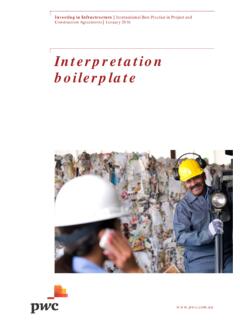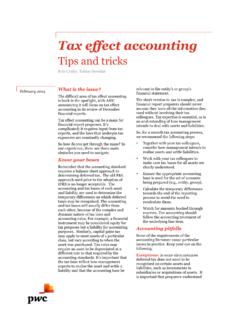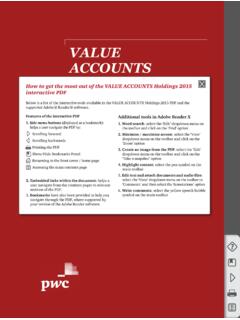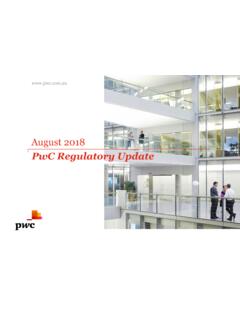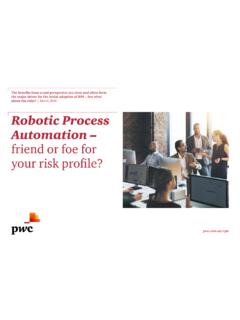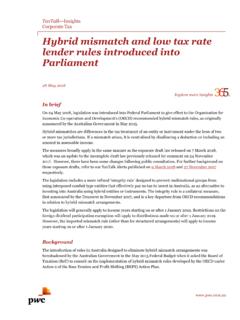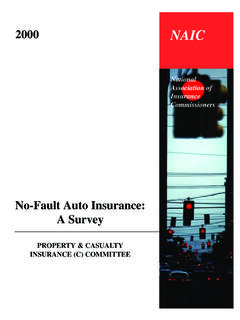Transcription of Broking 2020 - PwC
1 Broking 2020: Leading from the front in a new era of riskProtecting against a new breed of emerging risks requires co-ordination across corporations, insurance companies and policymakers. insurance brokers are ideally placed to lead this risk facilitation . But as the pace of change within the marketplace accelerates, a major rethink of how they operate and compete is likely to be | Broking 2020: Leading from the front in a new era of riskAbout the researchThe findings within this report are based on an in-depth survey of risk buyers (typically Heads of Risk or CFOs) from multinational corporations. The participants bring together a range of sectors and company sizes. In addition, we undertook face-to-face interviews with Steve Hearn, Deputy CEO of the Willis Group, Daniel S. Glaser, President and Chief Executive Officer of Marsh & McLennan Companies, and Dominic Christian, Executive Chairman of Aon Benfield | 3 ContentsIntroduction: A new era iInsurance 2020: Future of insurance 11.
2 Forces transforming the risk landscape 22. Consultative Broking demands broader information gathering, insight and collaboration 83. Stepping up to the demands of a new world 14 Conclusion: Out in front 19i | Broking 2020: Leading from the front in a new era of riskIntroduction: A new eraWe re pleased to introduce Broking 2020: Leading from the front in a new era of world is facing an increasingly complex, uncertain and, in some important areas, under-insured risk environment. For example, climatic and geopolitical instability are making once unthinkable losses seem almost commonplace as illustrated in Figure 1, which highlights the sharp rise in average catastrophe losses since the at past responses to shifts in the risk environment, Figure 2 outlines significant claims that have affected industry practices in recent decades. Figure 3 highlights the potentially dangerous economic impact by revealing the growing gap between insured and uninsured 1: Global catastrophe insured losses 1970 to 2013 Source: Guy Carpenter Global Catastrophe Review 2013 Figure 1: Global catastrophe insured losses 1970 to 2013 USD Billions03060901201502013201220112010200 9200820072006200520042003200220012000199 9199819971996199519941993199219911990198 9198819871986198519841983198219811980197 9197819771976197519741973197219711970 NaturalMan made10-year moving averagePwC | iiFigure 2: Significant claims that affected industry practicesInsured losses vs.
3 Uninsured losses, 1970 2013 Economic loss = insured + uninsured lossesSource: Swiss Re Economic Research & ConsultingInsured lossesUninsured losses10-year average insured losses10-year average total economic losses0100200300400In USD bn, at 2013 pricesFigure 3: Insured losses versus uninsured losses, 1970 2013 Source: PwC analysis1970 s: Flixborough Vapour Cloud: Revamped petrochemical coverage and protection1980 s: Deering Milliken Carpet Factory Loss: Revamped property coverage and highly protected risk (HPR) specifications 1980 s 90 s: Asbestos Class Action Suits: Revamped product liability limits and created new structure for coverage2001 9/11: Impacted across the coverage spectrum with $44 billion in losses 2011 Thai Floods: Highlighted and redirected approach to supply chain risks Source: Swiss Re Sigmaiii | Broking 2020: Leading from the front in a new era of riskEscalating exposuresThe risk of loss is likely to continue to increase.
4 An example of this is how the globalised economy is creating ever more diffuse and vulnerable supply chains. In turn, growing reliance on technology is introducing an array of new and escalating risks in areas ranging from cyber-attack to the potential for sharply rising losses and ever more complex loss drivers, the evolving risk environment can no longer be managed solely through traditional approaches. Solving these complex and dangerous challenges requires a comprehensive risk facilitation leader to educate, promote and co-ordinate solutions across a range of stakeholders including corporations, insurance /reinsurance companies, capital markets, and policymakers facilitation leaderSo what are the implications for brokers? As the traditional intermediary in the risk transfer chain, brokers are ideally placed to identify and develop viable and innovative solutions to the changing risk environment to be global risk facilitation leaders.
5 We believe there are a number of ways that brokers can ensure they stay on top of the frenetic pace of change in this new era of risk: Adapt business and operating models to simultaneously support both cost-efficient standard risk management and a knowledge-intensive consultative interaction with clients Expand their information gathering network to better anticipate and understand the new and emerging risks facing their clients Improve their ability to collect, integrate, analyse and communicate data to create actionable insights shifting to more of an analytical/consultative brokerEmerging risks are the number one priority for risk functions in the companies we | iv The world we have made as a result of the level of thinking we have done thus far creates problems we cannot solve at the same level of thinking at which we created them. Albert Einstein Macro trends are structurally changing every aspect of how brokersoperate in today s and tomorrow s marketsFacilitating private-public risk-relateddialogueCustomer revolution Power shifting more to customers on standardised risks Potential new business opportunities on a variety of emerging risks New business in niche marketsDemands for profitability and capital stewardship Investing in IT to gain efficiencies Dealing with the black swan problem Economically managing a wide variety of ever changing risksInformation and analytical sophistication New markets, new products Technology/analytical investments for economic insights/innovationInsurancebrokersare becoming risk facilitationleadersConnecting stakeholders with key emerging market/customer trendsv | insurance 2020 The future of Broking .
6 Keeping pace with a new era of risk and risk managementThe way forwardIn this paper, we look at the forces reshaping the marketplace and what would enable brokers to come out in front. Our exploration of the future of Broking draws upon interviews with Dominic Christian, Executive Chairman of Aon Benfield International, Daniel S. Glaser, President and Chief Executive Officer of Marsh & McLennan Companies, Steve Hearn, Deputy CEO of the Willis Group. The report also draws on the findings of PwC s survey of risk service buyers from a range of large international corporations, who discussed their changing priorities and expectations. We would like to thank the contributors for providing their valuable time and emerges from our analysis is that while brokers are generally seen as trusted advisors , their clients expectations are changing faster than ever and others are vying to take on this partnership role.
7 In relation to the increasingly complex and constantly shifting non-standard risks, risk managers are looking for consultative partners , who have the necessary knowledge of their risk challenges and who can develop the solutions they can t afford to create themselves. Meeting these demands is likely to require rapid and extensive adjustments in brokers business and operating models, especially as they will still have to provide cost-effective solutions for standard risks. Our exploration of how brokers can respond focuses in particular on cyber risk and nanotechnology, two of the risks that characterise this unfamiliar and challenging risk landscape. We hope that you find the paper challenging and useful. If you would like to discuss any of the issues presented in more detail, please speak to your usual PwC contact or one of the authors LawGlobal Leader, insurance PwC UKT: +44 207 213 3596E: Mayock Global insurance Brokerage Leader PwC UST: +1 646 471 5090E: Shanker Principal PwC Strategy& (US) Inc.
8 T: +1 312 578 4581 E: YoderGlobal insurance Advisory Leader PwC UST: +1 312 298 3462 E: Change always brings new risk, and ways of doing things. On this basis, this should change the landscape for broker support and services. Survey participantPwC | 1 insurance 2020: Future of insuranceBroking 2020: Leading from the front in a new era of risk is the latest viewpoint in PwC s insurance 2020 series, which explores the mega trends that are reshaping the competitive environment for insurers, brokers, policyholders and the markets in which they clients are using the insurance 2020 materials to help them judge the implications of these trends for their particular organisations and to Source: PwC analysisdetermine the strategies needed to respond. The central message from insurance 2020 is that whatever organisations are doing in the short-term be this dealing with market instability or just going about day-to-day business they need to be looking at how to keep pace with the sweeping Social, Technological, Economic, Environmental and Political (STEEP) developments that are transforming the world.
9 1 and driversSTEEP drivers1. SocialCustomer behaviours: Social networking Customer expectations Risk awareness HealthTalent drainStakeholder trustCorporate social responsibility2. TechnologicalInformation and analyticsDevices and sensorsSoftware and applicationsMedical advances5. PoliticalRegulatory reformGeo-political riskRise of state-directed capitalismTerrorismTax treatmentSharia compliance (Takaful)4. EnvironmentalClimate change & catastrophesSustainabilityPollutionSTEEP driversEconomicEnviron-mentalTechno-logi calSocialPolitical124353. EconomicUrbanisationNew growth opportunitiesFiscal pressureInflation/DeflationRisk sharing & transferSocial security & benefitsDistributor shiftPartnerships2 | Broking 2020: Leading from the front in a new era of risk1. Forces transforming the risk landscapeEstablished approaches to risk management are now being outflanked and outpaced by the contagious speed and connectivity of new, evolving and escalating risks (known and as yet unknown).
10 PwC | 32 Technology Technology is transforming how people communicate and conduct business. For brokers, technology can help to boost information flows and value-adding analytical capabilities on the one side and take costs out of distribution and service on the other. As such, it is opening up new ways of engaging with risk managers, insurers and reinsurers and providing the basis for richer discussions and sharper insights. Yet technology also presents difficult challenges across the different market segments. For brokers whose client base includes large risk management The disruptive forces that are reshaping the global risk landscape and their impact on businesses, brokers, insurers/reinsurers and governments can be framed using our STEEP framework:1 Social Social media2 is changing how businesses engage with their customers and with each other. The tracking of these interactions is providing valuable new sources of big data insight.
